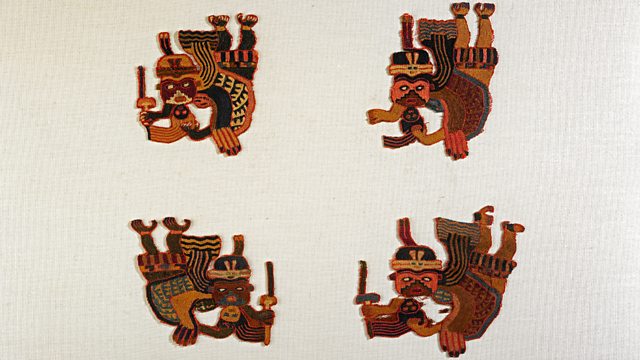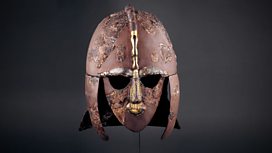Paracas Textile Fragment
Neil MacGregor's history of humanity told through objects. Today, textiles from Peru that have remarkably survived for over 2000 years
A history of the world described through individual objects at the British Museum. This week Neil MacGregor, the Museum's Director, is looking at what was happening around the world between 2000-3000 years ago.
The theme so far has been one of empires collapsing, new regimes and warfare. In South America there were no new empires and we still don't entirely understand the cultures that were thriving there. In this programme, Neil MacGregor shows off some of the remarkably preserved textiles discovered in the Paracas peninsula on the southern coast of Peru and tries to piece together what life might have been like for these people living in around 500 BC. The early Peruvians went to astonishing lengths to make and decorate their textiles whose colours remain striking to this day. What were they for and what do they tell us about beliefs of this time?
Last on
![]()
Discover more programmes from A History of the World in 100 Objects about death and ritual
About this object
Location: Paracas, Peru
Culture: Incas and South America
Period: About 300-200 BC
Material: Cloth
听
These textile fragments are made of alpaca or llama wool and would originally have been part of a cloak. They depict flying shamans grasping human heads in their talons. The bottom figure carries a knife used to behead his victim. They were found wrapped around mummified bodies in the great Paracas Necropolis in Peru. These 2000-year-old textiles were preserved in the dry, dark conditions of the tomb.
Who were the Paracas cultures?
The Paracas textiles come from a period in South American history when crops, llamas and guinea pigs were first domesticated and distinct social classes emerged for the first time. Textiles were valued by the Paracas above all other things and they were worn to indicate status and authority. Some textiles were over 34 metres long and would have required large numbers of people and complex organization to make. The Paracas and other contemporary communities laid the foundations for the later societies of the Andes, including the Inca.
Did you know?
- Alpaca fibre is naturally fire resistant, and hypo-allergenic.
Still bright after 2,000 years
By Pippa Cruickshank and Helen Wolfe, Conservation, British Museum
听
These textiles have survived in such good condition due to the dark and very dry environment in which they were buried. The brilliant colours were all produced using natural dyes.
Natural dyes often lose their colour when exposed to light or water which makes the brightness of these 2,000 year old textiles so extraordinary.
The figures are embroidered using finely spun threads made from camelid wool (likely to be llama or alpaca). They completely cover the plain weave cotton base cloth. The fragments were once part of a larger cloth but were cut out some time before becoming part of the British Museum collection.
Conservators often secure such fragile textiles to a supporting backing fabric by stitching with very fine silk thread. But the structure of these textiles is so dense that passing a needle through them would be likely to damage the fibres.
These vulnerable textiles are instead held between two rigid supports so they can be displayed. The fragments were first laid on a padded fabric-covered board. Depressions were made in the padding beneath the fragments to ensure there is even contact with the Perspex glazing that gently holds the textiles in place. The backing fabric has been dyed with modern synthetic dyes that have good light and water fastness so the colours stay bright and there is no possibility of transfer to the ancient textile fragments.
While the textiles are on display low lighting levels will help to minimise any fading of the colours.
Transcript
Broadcasts
- Thu 18 Feb 2010 09:4591热爆 Radio 4 FM
- Thu 18 Feb 2010 19:4591热爆 Radio 4
- Fri 19 Feb 2010 00:3091热爆 Radio 4
- Thu 20 Aug 2020 13:4591热爆 Radio 4
Featured in...
![]()
Death—A History of the World in 100 Objects
More programmes from A History of the World which relate to the ritual of death.
Podcast
-
![]()
A History of the World in 100 Objects
Director of the British Museum, Neil MacGregor, retells humanity's history through objects





